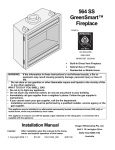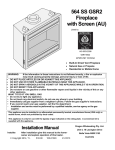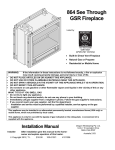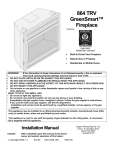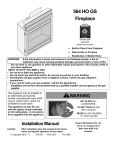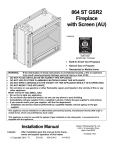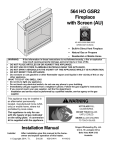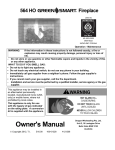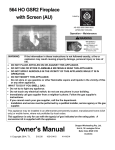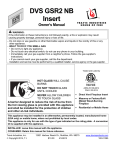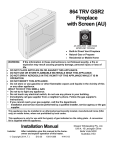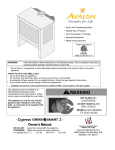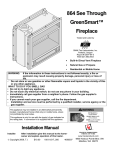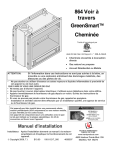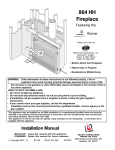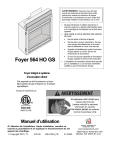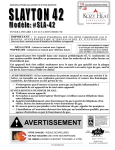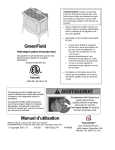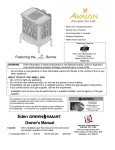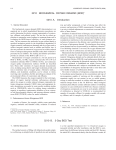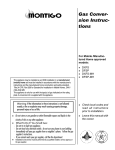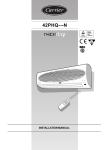Download Dragon Wholesaling 564 Diamond-Fyre Installation manual
Transcript
564 Diamond-Fyre™ Fireplace Listed by AS 4553-2008 GMK10022 IAPMO-R&T OCEANA • Built-In Direct Vent Fireplace • Natural Gas or Propane Residential or Mobile Home • WARNING: If the information in these instructions is not followed exactly, a fire or explosion may result causing property damage, personal injury or loss of life. - Do not store or use gasoline or other flammable vapors and liquids in the vicinity of this or any other appliance. WHAT TO DO IF YOU SMELL GAS • Do not try to light any appliance. • Do not touch any electrical switch; do not use any phone in your building. • Immediately call gas supplier from a neighbor's phone. Follow the gas supplier's instructions. • If you cannot reach your gas supplier, call the fire department. - Installation and service must be performed by a qualified installer, service agency or the gas supplier. This appliance may be installed in an aftermarket permanently located, manufactured home (USA only) or mobile home, where not prohibited by local codes. This appliance is only for use with the type(s) of gas indicated on the rating plate. A conversion kit is supplied with the appliance. Installation Manual Installer: Dragon Wholesaling Pty. Ltd. After installation give this manual to the homeowner and explain operation of this heater. © Copyright 2010, T.I. $10.00 100-01257_000 4101014 Unit 2, 16 Lexington Drive Bella Vista NSW 2153 Australia 2 Introduction Overview This manual details the installation requirements for the 564 DF fireplace. For operating and maintenance instructions, refer to the 564 DF Owner's Manual (part # 100-01258). Listing Details This appliance was listed by SAI Global to AS 4553-2008. The listing label is attached to the appliance near the gas control valve. © Travis Industries 4101014 100-01257_000 Table of Contents Introduction Installation (continued) Overview ............................................................................. 2 Listing Details ...................................................................... 2 Safety Precautions Safety Precautions .............................................................. 4 Features and Specifications Features .............................................................................. 6 Installation Options.............................................................. 6 Heating Specifications ......................................................... 6 Dimensions ......................................................................... 6 Hearth Requirements .......................................................... 32 Facing Requirements .......................................................... 33 Drywall Installation .......................................................... 33 Facing Overview ............................................................. 34 Optional Faceplates – Sizing Chart ................................. 34 Thin Facing Installation ................................................... 35 Thick Facing Installation .................................................. 37 Thick Facing Installation with FPX Arched Faces............ 38 Mantel Requirements .......................................................... 40 Install Example - Build-Out (Dog-House) w Hor. Term. ...... 41 Install Example - Build-In w Hor. Term................................ 42 Finalizing the Installation Installation Packing List ......................................................................... 7 Additional Items Required ................................................... 7 Installation Overview ........................................................... 7 Recommended Installation Procedure ................................ 7 Top Stand-Off Assembly ..................................................... 8 Converting the Fireplace to Top Vent Configuration ........... 9 Fireplace Placement Requirements .................................... 11 Clearances ...................................................................... 11 Raised Fireplaces ............................................................ 11 Min. Framing Dims. - Rear Vent Configuration ...........................12 Min. Framing Dims. - Top Vent Configuration ................. 13 Nailing Brackets .............................................................. 14 Corner Installations - Rear Vent Configuration ................ 15 Corner Installations - Top Vent Configuration .................. 16 Gas Line Requirements ...................................................... 17 Fuel ................................................................................. 17 Gas Line Connection ....................................................... 17 Gas Inlet Pressure ........................................................... 17 Gas Line Location............................................................ 17 Electrical Connection (required) .......................................... 19 Optional Wall Switch or Thermostat Installation .................. 20 Vent Requirements ............................................................. 21 Vent Clearances .............................................................. 21 Altitude Considerations.................................................... 21 Approved Vent ................................................................. 22 Vent Installation ............................................................... 22 Approved Vent Configurations ............................................ 23 Restrictor Position ........................................................... 23 Exhaust Restrictor Adjustment ........................................ 23 Intake Restrictor Adjustment ........................................... 24 Diffuser Plate Adjustment ................................................ 25 Rear Vent Config. W Horizontal Term. (no vertical rise) ..... 26 Rear Vent Config. W Horizontal Term. (w vertical rise) ....... 27 Rear Vent Configuration with Vertical Termination .............. 28 Top Vent Configuration with Horizontal Termination ........... 29 Top Vent Configuration with Vertical Termination ............... 30 Termination Requirements .................................................. 31 © Travis Industries 3 Air Shutter Adjustment .................................................... 44 Glass Frame Removal and Installation ............................... 45 LP Conversion Instructions ................................................. 52 Optional Equipment Grill Installation ................................................................... 56 Index Index ................................................................................... 58 4101014 100-01257_000 4 Safety Precautions Safety Warnings: • Failure to follow all of the requirements may result in property damage, bodily injury, or even death. • This unit must be installed by a qualified installer to prevent the possibility of an explosion. • This appliance must be installed in accordance with all local codes, if any; if not, in U.S.A. follow ANSI Z223.1 and NFPA 54(88). • A manufactured home (USA only) or mobile home OEM installation must conform with the Manufactured Home Construction and Safety Standard, Title 24 CFR, Part 3280, or, when such a standard is not applicable, the Standard for Manufactured Home Installations, ANSI/NCSBCS A225.1, or Standard for Gas Equipped Recreational Vehicles and Mobile Housing, CSA Z240.4. This appliance may be installed in Manufactured Housing only after the home is site located. • All exhaust gases must be vented outside the structure of the living-area. Combustion air is drawn from outside the living-area structure. The venting must not be connected to a chimney flue serving a separate solid-fuel burning appliance. • Notify your insurance company before hooking up this fireplace. • The room heater should be inspected before use and at least annually by a qualified service person. More frequent cleaning may be required due to excessive lint from carpeting, bedding material, etc. • The instructions in this manual must be strictly adhered to. Do not use makeshift methods or compromise in the installation. Improper installation will void the warranty and safety listing. • This heater is approved for use with natural gas (NG) or propane (LP). Burning the incorrect fuel will void the warranty and safety listing and may cause an extreme safety hazard. Direct questions about the type of fuel used to your dealer. Check the label and flame adjust knob on the gas control valve. • Contact your local building officials to obtain a permit and information on any installation restrictions or inspection requirements in your area. • If the flame becomes sooty, dark orange in color, or extremely tall, do not operate the heater. Call your dealer and arrange for proper servicing. • It is imperative that control compartments, screens, or circulating air passageways of the heater be kept clean and free of obstructions. These areas provide the air necessary for safe operation. • Do not operate the heater if it is not operating properly in any fashion or if you are uncertain. Call your dealer for a full explanation of your heater and what to expect. • Do not store or use gasoline or other flammable liquids in the vicinity of this heater. • Do not operate if any portion of the heater was submerged in water or if any corrosion occurs. • Do not place clothing or other flammable items on or near the heater. Because this heater can be controlled by a thermostat there is a possibility of the heater turning on and igniting any items placed on or near it. • Light the heater using the built-in igniter. Do not use matches or any other external device to light your heater. • Never remove, replace, modify or substitute any part of the heater unless instructions are given in this manual. All other work must be done by a trained technician. Don't modify or replace orifices. • The viewing glass should be opened only for conducting service. • Any safety screen or guard removed for servicing must be replaced prior to operating the heater. Travis Industries 4101014 100-01257_000 Safety Precautions 5 Safety Warnings (continued): • Do not place articles on or against this appliance. • Do not use or store flammable materials near this appliance. • Do not spray aerosols in the vicinity of this appliance while it is in operation. • Do not modify this appliance • Servicing shall be carried out only by authorized personnel. • Allow the heater to cool before carrying out any maintenance or cleaning. • Operate the heater according to the instructions included in this manual. • If the main burners do not start correctly turn the gas off and call your dealer for service. • This unit is not for use with solid fuel. • Do not place anything inside the firebox (except the included components). • Do not throw this manual away. This manual has important operating and maintenance instructions that you will need at a later time. Always follow the instructions in this manual. • Do not touch the hot surfaces of the heater. Educate all children of the danger of a high-temperature heater. Young children should be supervised when they are in the same room as the heater. • Due to the high temperature, the heater should be located out of traffic and away from furniture and draperies. • Instruct everyone in the house how to shut gas off to the appliance and at the gas main shutoff valve. The gas main shutoff valve is usually next to the gas meter or propane tank and requires a wrench to shut off. • Travis Industries, Inc. grants no warranty, implied or stated, for the installation or maintenance of your heater, and assumes no responsibility of any consequential damage(s). © Travis Industries 4101014 100-01257_000 6 Features and Specifications Installation Options • Residential or Mobile Home • Raised or Floor Placement • Straight or Corner Placement • Internal or External Chase • Flush or Recessed Face • Horizontal or Vertical Vent • Bedroom Approved Heating Specifications Natural Gas Propane Approximate Heating Capacity (in square feet)* 950 950 Approximate Heating Capacity (in square meters)* 88 88 20,500 20,500 21.6 21.6 Maximum BTU Input Per Hour Maximum Megajoules (MJ) Input Per Hour * ** Heating capacity will vary with floor plan, insulation, and outside temperature. Efficiency rating is a product thermal efficiency rating determined under continuous operation independent of installed system. Dimensions Top Vent Configuration 8" (203mm) Diameter Vent 4-3/4" Rear Vent Configuration 121mm 8" (203mm) Diameter Vent 33-1/4" 845mm 31-3/4" 794mm 30-1/4" 768mm 28-3/4" 730mm 18-3/4" 32-1/2" ce pla 476mm 826mm ck of e Fir Ba 1" 25mm 30"* 762mm 24-1/4" 616mm ht Rig 36-1/4" 921mm 16-1/4"* 413mm ft Le Fro nt Weight: 155 Lbs. (70.4kg) * Includes the required 1/2" (13mm) clearance. Travis Industries 4101014 100-01257_000 Installation 7 (for qualified installers only) Packing List • • Propane Conversion Kit Firestop (sku 250-00747) Additional Items Required • • • • • • Direct Vent Gas Line Equipment (shutoff valve, pipe, etc.) Electrical Equipment Crushed Glass (Platinum 94500580 – Bronze 94500581 – Cobalt 94500582) 564DF Firebacks (Stainless Steel 96100208 - Black Enamel 96100210 - Painted Black 96100211) Face or Grill Kit Installation Overview • All requirements below must be met. Top Vent Configuration See the section See the section "Vent Requirements" Rear Vent Configuration "Mantel Requirements" See the section "Approved Vent Required Travis Firestop (sku 250-00747) Configurations" Insulation must not fill the 1/2" (13mm) Side Wall Drywall clearance around the Drywall 1" Min. 25mm back and sides of the fireplace. Nailing Brackets See the section "Minimum Framing Dimensions" See "Optional NonCombustible Facing" See "Optional NonCombustible Hearth" See the section See the section "Gas Line Installation" "Electrical Connection" Recommended Installation Procedure • Frame the opening for the fireplace. Make sure to allow for vent installation. • This fireplace is designed to accommodate 1/2" (13mm) or 5/8" (16mm) drywall (see "Nailing Brackets" on page 14 for details). Secure the fireplace to the framing. • Install the vent, gas line and electrical hook-up. • Install the drywall. • Install the hearth (if applicable). • Install the facing (if applicable). • Install the mantel (if applicable). • Finalize the installation and install the grill or face. © Travis Industries 4101014 100-01257_000 8 Installation (for qualified installers only) Top Stand-Off Assembly The top stand-offs must be assembled prior to installation. Warning: You must follow the instructions below to elevate both standoffs. Failure to do so will result in an extreme fire hazard. The standoffs are shipped in the flat position. Make sure to follow the instructions below before installing the fireplace. 2 AFTER Standoff 1 3 1/4" Nutdriver BEFORE a Bend the standoff in the numbered sequence shown above. b Remove the screw below the standoff. c Travis Industries 4101014 Replace the screw to secure the standoff. 100-01257_000 Installation 9 (for qualified installers only) Top Vent or Rear Vent Configuration This appliance is shipped in the rear vent configuration. To change to the top vent configuration, follow the directions below. NOTE: the vent configuration affects several aspects of installation (framing, maximum vent rise, maximum vent run). Make sure the vent configuration is correct prior to installation. You may wish to configure the diffuser when changing the vent configuration. Converting the Fireplace to Top Vent Configuration NOTE: Use a magnetic-tipped Remove and discard the nutdriver on these screws - take heat shield. Replace the 4 care to prevent the screws from removed screws. falling into the fireplace. ce pla ire fF o op T Remove the 4 screws securing the ck Ba ce pla ire F of outer flue assembly. Place the screws and assembly aside. Remove the 4 screws securing the inner flue assembly. Place the Remove the 4 screws securing the screws and assembly aside. intake cover plate. Place the screws and cover plate aside. Remove and discard the insulation found below the large cover plate. © Travis Industries 4101014 100-01257_000 10 Installation (for qualified installers only) Converting the Fireplace to Top Vent (continued) Remove the 4 screws securing the exhaust cover plate. Verify the gasket on the cover plate is in place, then attach it to the rear-facing exhaust port with the same screws. Verify the gasket on the intake cover plate is in place, then attach it to the rear of the fireplace using the screws removed earlier. Verify the gasket on the inner flue assembly is in place, then attach it to the upward-facing exhaust port using the screws removed earlier. Verify the gasket on the outer flue assembly is in place, then attach it to the top of the fireplace using the screws removed earlier. Travis Industries 4101014 100-01257_000 Installation 11 (for qualified installers only) Fireplace Placement Requirements • The fireplace requires a 1/2" (13mm) clearance from the angled sides and back of the fireplace to the framing members. No material (insulation, framing, etc.) may be placed into this area. • Fireplace must be installed on a level surface capable of supporting the fireplace and vent • Fireplace must be placed directly on wood or non-combustible surface (not on linoleum or carpet) • This heater may be placed in a bedroom. Please be aware of the large amount of heat this appliance produces when determining a location. Clearances • When installed, walls in front of the fireplace must be a minimum 1" (25mm) to the side of the fireplace. • Due to the high temperature, the heater should be located out of traffic and away from furniture and draperies. • Fireplace must be placed so the vents below and above the glass do not become blocked. Raised Fireplaces • The fireplace (and hearth, if desired) may be placed on a platform designed to support the fireplace (155 Lbs.70 Kg) and vent. © Travis Industries 4101014 100-01257_000 12 Installation (for qualified installers only) Minimum Framing Dimensions - Rear Vent Configuration Included Firestop (required) HINT: place the fireplace so the center Part # 250-00747 line is at least 5" (127mm) from both vertical framing members at the rear (this allows the vent to pass through the framing without modfications) Vent Clearances for 8" (203mm) dia. Vent: 1" (25mm) to the sides, 1" (25mm) below, and 4" (102mm) above the vent to combustibles. Center of Rear Vent Minimum 38" (965mm) 24-1/4" Fireplace Enclosure Height 32-1/2" 616mm 826mm Route the electrical line to a position to the 19-1/4" left rear of the 33-1/2" fireplace. 851mm 489mm 36-1/2" 927mm 16-1/2" 419mm The on/off switch/thermostat wire (if used) should be routed to a location near the right front of the fireplace. Travis Industries 4101014 100-01257_000 Installation (for qualified installers only) 13 Minimum Framing Dimensions - Top Vent Configuration Route the electrical line to a position to the left rear of the fireplace. 33-1/2" 851mm 36-1/2" 16-1/2" 927mm 419mm Minimum enclosure height = 36-1/4" (921mm) The on/off switch/thermostat wire (if used) should be routed to a location WARNING: A cut-out for the gas line near the right front of the fireplace. may be required on the framing. See the dimensions under "Gas Line Connection" for details. © Travis Industries 4101014 100-01257_000 14 Installation (for qualified installers only) Nailing Brackets There are four nailing brackets on the front of the fireplace. Follow the directions below to prepare the nailing brackets. Once in place, nail or screw the nailing brackets to the framing. WARNING: Make sure the fireplace is square and plumb when placed in the framing. Measured corner-tocorner, the fireplace should be square (approx. 47-1/8" (1197mm) for each dimension). Use shims to insure the fireplace is square. NOTE: Additional nailing brackets are provided along the base of the fireplace. Use these brackets if not using the front brackets. TOP VIEW 1/2" (13mm) Drywall Framing For installations using 1/2" (13mm) facing fold the larger tab out 90° (use a screwdriver if necessary). Fireplace Nailing Bracket Drywall TOP VIEW 5/8" (0.625mm) Drywall Framing For installations using 5/8" (0.625mm) drywall fold the shorter tab out 90° (use a screwdriver if necessary). Travis Industries Fireplace Nailing Bracket Drywall 4101014 100-01257_000 Installation 15 (for qualified installers only) Corner Installations - Rear Vent Configuration A typical 45° installation uses the framing dimensions shown in the illustration below (NOTE: all clearances still apply). 564 SS Firestop Minimum 1" (25mm) Clearance Minimum 1/2" (13mm) Clearance 7" (178mm) Approximate (varies due to vent installation) NOTE: Most installations use: 6" (152mm) Section for 2x6 (51mm X 152mm) Walls 4" (102mm) Section for 2x4 (51mm X 102mm) Walls 44-1/2" Min. 1130mm © Travis Industries 4101014 100-01257_000 16 Installation (for qualified installers only) Corner Installations - Top Vent Configuration A typical 45° installation uses the framing dimensions shown in the illustration below (NOTE: all clearances still apply). Minimum 1/2" (13mm) Clearance 14-1/4" 362mm 44-1/2" Min. 1130mm Travis Industries 4101014 100-01257_000 Installation 17 (for qualified installers only) Gas Line Requirements • • • The gas line must be installed in accordance with all local codes, if any; if not, follow ANSI 223.1 and the requirements listed below. The fireplace and gas control valve must be disconnected from the gas supply piping during any pressure testing of that system at test pressures in excess of 1/2 psig. For pressures under 1/2 psig, isolate the gas supply piping by closing the manual shutoff valve. Leak test all gas line joints and the gas control valve prior to and after starting the fireplace. Fuel • This fireplace is designed either for natural gas or for propane (but not for both). Check the sticker on the top of the gas control valve to make sure the correct fuel is used. Gas Line Connection • Installation must be performed by a qualified installer, service agency or the gas supplier (In Massachusetts a licensed plumber/gasfitter). Standard Input Pressure Gas Inlet Pressure Natural Gas Propane • • 7" W.C. (1.74 kPA) 13" W.C. (2.73 kPA) If the pressure is not sufficient, make sure the piping used is large enough, the supply regulator is adequately adjusted, and the total gas load for the residence does not exceed the amount supplied. The supply regulator (the regulator that attaches directly to the residence inlet or to the propane tank) should supply gas at the suggested input pressure listed above. Contact the local gas supplier if the regulator is at an improper pressure. © Travis Industries 4101014 100-01257_000 18 Installation (for qualified installers only) Gas Line Location Right Side Gas Inlet (preferred) A 3" (76mm) high by 2" (51mm) wide opening is A 6" (152mm) flex tube and shutoff located behind the gas inlet cover plate. It is 7-3/4" valve is included with the fireplace. (197mm) behind the front and 1-3/4" (44mm) above the base of the fireplace. The shutoff valve accepts a 1/2"MPT. 8-3/4" 222mm 13-3/4" 349mm The gas inlet is located 2-1/2" (64mm) above the base of the fireplace. You may remove this cover plate to install the gas line. The cover plate has a 7/8" (.0875mm) diameter hole (covered with a push plug) in line with the gas inlet on the gas control valve. By rotating the plate 180° the hole may be re-located. You may also secure the plate in a customized location using the self-drilling screws. Left Side Gas Inlet A 6" (152mm) flex tube and shutoff valve is A 3" (76mm) high by 2" (51mm) wide opening is included with the fireplace. You may wish to located behind the gas inlet cover plate. It is 4-3/4" use a 24" (610mm) flex tube. The shutoff valve (121mm) behind the front and 1-3/4" (44mm) above accepts a 1/2" MPT. the base of the fireplace. 8-3/4" 222mm You may wish to route the flex line along 13-3/4" 349mm the front edge of the fireplace to conceal it. You may remove this cover plate to install the gas line. The cover plate has a 7/8" (0.875mm) diameter hole (covered with a push plug). By rotating the plate 180° the hole may be re-located. You may also secure the plate in a customized location using the self-drilling screws. Travis Industries 4101014 100-01257_000 Installation 19 (for qualified installers only) Electrical Connection (required) • The electrical line must be installed by a qualified installer and must meet all local codes. • Make sure the household breaker is shut off prior to working on any electrical lines. • The appliance, when installed, must be electrically grounded in accordance with local codes or, in the absence of local codes, with the National Electrical Code, ANSI/NFPA 70, or the Canadian Electrical Code, CSA C22.1. • The electrical line must supply 240 Volts at 60 Hz (2 Amps). Caution: Label all wires prior to disconnection when servicing controls. Wiring errors can cause improper and dangerous operation. © Travis Industries 4101014 100-01257_000 20 Installation (for qualified installers only) Optional Wall Switch or Thermostat Installation Do not connect 110-240 VAC to the gas control valve or wiring system of this fireplace. The switch must be installed by a qualified installer. This fireplace may be installed with an optional wall switch or thermostat. The thermostat (or on/off switch) wire should be passed through the grommet on either side of the fireplace near the gas inlet (see item “a” below). The thermostat (or on/off switch) wires will interrupt the burner circuit (see item “b” below). • If you wish to bypass the switch, connect the thermostat (on/off switch) wires directly to the green and white wires (see “c” below). • If you wish keep the switch (series) – re-align the wires as shown in item “d” below. NOTE: The on/off switch must be in the “ON” position for the thermostat (or on/off switch) to operate. Burner Circuit Wires POWER SUPPLY Black Red Black Red Red Red ON / OFF Blue Red b Green White Black Blue a Thermostat Wire Grommet AA BATTERY TRAY COMFORT CONTROL c Bypass d Thermostat or MAIN BURNER Series White On/Off Switch Thermostat or Green Green On/Off Switch White Caution: Label all wires prior to disconnection when servicing controls. Wiring errors can cause improper and dangerous operation. Note: When using a GreenSmart™ remote, use the receiver for on/off operation. Travis Industries 4101014 100-01257_000 Installation 21 (for qualified installers only) Vent Requirements • The gas appliance and vent system must be vented directly to the outside of the building, and never be attached to a chimney serving a separate solid fuel or gas-burning appliance. Each direct vent gas appliance must use it's own separate vent system. • In addition to the requirements listed here, follow the requirements provided with the vent. • A firestop is required whenever the vent penetrates a wall, floor, or ceiling (passes through framing members). Horizontal vent less than 48" (1219mm) above the fireplace must use the Travis Firestop (sku 250-00747 - it incorporates a 4" (102mm) clearance above, 1"( 25mm)clearance below and to the sides of the vent). Other penetrations only require a 1" (25mm) clearance and may use a standard firestop (make sure the required 1" (25mm) clearance is met). • Always use the high-wind termination (if available from the vent manufacturer). Vent Clearances • The vent must maintain the required clearance to combustible materials to prevent a fire. Do not fill air spaces with insulation. Before 48" (1219mm) After 48" (1219mm) Rise Rise Sides 1" (25mm) 1" (25mm) Above 4" (102mm) 1" (25mm) Below Horizontal or 45° Section 1" (25mm) 1" (25mm) Vertical Termination Horizontal Required Firestop Termination Use a roof flashing and storm collar whenever passing through the roof Use a firestop whenever Min. 4" (102mm) passing through a ceiling 1" (25mm) if a minimum 48" (1219mm) above the Use a support box on exposed vent fireplace. Min. 1" 25mm Min. 1" Min. 1" 25mm 25mm Altitude Considerations • This heater has been tested at altitudes ranging from sea level to 6,000 feet (1800M). In this testing we have found that the heater, with its standard orifice, burns correctly with just an air shutter adjustment. • Failure to adjust the air shutter properly may lead to improper combustion which can create a safety hazard. Consult your dealer or installer if you suspect an improperly adjusted air shutter. © Travis Industries 4101014 100-01257_000 22 Installation (for qualified installers only) Approved Vent • Rear vent configurations use 8" (203mm) diameter Simpson Dura-Vent Model Direct-Vent Pro (or GS)*. • Top vent configurations use 8" (203mm) or 6-5/8" (168mm) diameter Simpson Dura-Vent Direct-Vent Pro (or GS)*. If using 6-5/8" (168mm) diameter vent, attach the 8" (203mm) to 6-5/8" (168mm) reducer (Travis part # 98900165) to the fireplace. NOTE: When using 6-5/8” (168mm) diameter vent, make sure to accommodate the 4” (102mm) clearance above the vent for the first 48” (1219mm) of rise (see vent clearances on page 21). Standard firestops do not include this clearance. * Other vent may be approved with this fireplace. Check with the vent manufacturer for details. • Always use the high-wind cap (or high-wind sconce cap, part # 58DVA-HSCH or 46DVA-HSCH). • Installation instructions for Simpson Dura-Vent may be found at www.duravent.com 6-5/8" (168mm) Diameter Vent Reducer - # 98900165 Vent Installation • Slide the vent sections together and turn 1/4 turn until the sections lock in place. • Screws are not required to secure the vent. However, three screws may be used to secure vent sections together if desired. • High temperature sealant is recommended at the appliance starter section connection (use high-temperature silicone or Mill-Pac®). • If disassembly is required, at time of re-assembly check to see if the vent creates a tight fit. If it does not, apply high temperature sealant to the joints of the affected sections. • Horizontal sections require a 1/4" (6mm) rise every 12" (305mm) of travel • Horizontal sections require non-combustible support every three feet (e.g.: plumbing tape) Travis Industries 4101014 100-01257_000 Installation 23 (for qualified installers only) Approved Vent Configurations Restrictor Position • Intake and exhaust restrictors are built into the appliance to adjust the flow rate of intake air and exhaust gases. Depending upon the vent configuration, you may be required to adjust the restrictor positions. The charts for acceptable vent configurations detail the correct vent restrictor positions. Exhaust Restrictor Adjustment If the diffuser is required to be in position # 2, you may wish to adjust the diffuser while the exhaust restrictor is removed. Firebo Back W all of F x Roo f The exhaust restrictor is shipped in postion # 0. If the restritor is required in a different postion, remove the screws, re-position the restrictor (see the illustration below), and replace the screws. irebox In this example, the restrictor is set in position # 3. (closed) #6 #5 #4 #3 #2 #1 (open - stock position) # 0 Back of Firebox © Travis Industries 4101014 100-01257_000 24 Installation (for qualified installers only) Intake Restrictor Adjustment Position # 1 (open) 1/4" Socket Loosen the two screws holding the intake restrictor in place.. Position # 2 (closed) Slide the restrictor down to the lower position and tighten the screws. Travis Industries 4101014 100-01257_000 Installation 25 (for qualified installers only) Diffuser Plate Adjustment Certain vent configurations require the diffuser plate to be adjusted (refer to the approved vent configuration charts for details). Position # 1 is stock (bent). Position # 2 is flattened. See the directions below to change the diffuser to position #2. Firebo Back W all of F x Roo irebox f Remove the exhaust restrictor. 1/4" Nutdriver 1/4" Nutdriver Remove the diffuser. DIFFUSER SIDE VIEW Before (Stock - Position # 1) Bend the round portion of the diffuser so it is flat (position # 2). After (Position # 2) Secure the flattened diffuser plate with the screws removed earlier. Replace the exhaust restrictor (see “Exhaust Restrictor Adjustment” for restrictor settings). © Travis Industries 4101014 100-01257_000 26 Installation (for qualified installers only) Rear Vent Configuration with Horizontal Termination (no vertical rise) • The termination must fall within the shaded area shown in the chart. Use the indicated restrictor and diffuser positions. See the charts below to determine maximum vent Termination Optional 45° Elbow Vent with No 45° Elbow 3 feet 915mm • Exhaust Restrictor # 0 (stock) • Intake Restrictor # 1 (stock) • Diffuser Position # 1 (stock) 4' (max) 610mm 0 feet mm 0 feet mm • Min. 4" (102mm) Horizontal Section • Max.48" (1.2m) Horizontal Section(s) Vent with 1 45° Elbow 3 feet 915mm • Exhaust Restrictor # 0 (stock) • Intake Restrictor # 1 (stock) • Diffuser Position # 1 (stock) Travis Industries • Min. 4" (102mm) Horizontal Section 2' (max) 1.2m 0 feet mm 0 feet mm • Max. 24" (610mm) Horizontal Section(s) 4101014 100-01257_000 Installation 27 (for qualified installers only) Rear Vent Configuration with Horizontal Termination (with vertical rise) • Up to four elbows (45° or 90°) may be used. • Only one horizontal elbow may be used. 20' max (6 m) 10 feet (3 m) 0 feet 15 feet (4.5 m) The termination must fall within the shaded area shown in the chart. Use the indicated restrictor and diffuser positions. 5 feet (1.5 m) • 22' max (6.7 m) 22' max (6.7 m) 20 feet (6 m) 20 feet (6 m) Exhaust Restrictor # 6 Intake Restrictor # 2 Diffuser Position # 2 15 feet (4.5 m) 15 feet (4.5 m) Exhaust Restrictor # 4 Intake Restrictor # 2 Diffuser Position # 2 10 feet (3 m) 10 feet (3 m) Exhaust Restrictor # 2 Intake Restrictor # 1 (stock) Diffuser Position # 1 (stock) 5 feet (1.5 m) 5 feet (1.5 m) 0 feet 20' max (6 m) 15 feet (4.5 m) 10 feet (3 m) 5 feet (1.5 m) 0 feet 0 feet H2 This is considered a horizontal Horizontal length is calculated by adding elbow (it does not matter both lengths of horizontal run whether it turns right or left). (Horizontal Length = H1 + H2). It may be a 90° or 45° elbow. H1 This is considered a vertical elbow © Travis Industries 4101014 100-01257_000 28 Installation (for qualified installers only) • Up to four elbows (45° or 90°) may be used. • Only one horizontal elbow may be used. 20' max (6m) 15 feet (4.5m) 10 feet (3m) The termination must fall within the shaded area shown in the chart. Use the indicated restrictor and diffuser positions. 5 feet (1.5m) • 0 feet Rear Vent Configuration with Vertical Termination 40' max (12m) 40' max (12m) 35 feet (10.5m) 35 feet (10.5m) 30 feet (9m) 30 feet (9m) Exhaust Restrictor # 6 Intake Restrictor # 2 Diffuser Position # 2 25 feet (7.5m) 25 feet (7.5m) 20 feet (6m) 20 feet (6m) Exhaust Restrictor # 4 Intake Restrictor # 2 Diffuser Position # 2 15 feet (4.5m) 15 feet (4.5m) Exhaust Restrictor # 2 Intake Restrictor # 2 Diffuser Position # 2 10 feet (3m) 10 feet (3m) 5 feet (1.5m) 5 feet (1.5m) 0 feet 20' max (6m) 15 feet (4.5m) 10 feet (3m) 5 feet (1.5m) 0 feet 0 feet H2 This is considered a horizontal Horizontal length is calculated by adding elbow (it does not matter both lengths of horizontal run whether it turns right or left). (Horizontal Length = H1 + H2). It may be a 90° or 45° elbow. H1 This is considered a vertical elbow Travis Industries 4101014 100-01257_000 Installation 29 (for qualified installers only) Top Vent Configuration with Horizontal Termination • May use 8" (203mm) or 6-5/8" (168mm) diameter vent (see page for 21 details). • Only one horizontal elbow may be used. 10 feet (3m) 20' max (6m) Up to four elbows (45° or 90°) may be used. 15 feet (4.5m) • 5 feet (1.5m) The termination must fall within the shaded area shown in the chart. Use the indicated restrictor and diffuser positions. 0 feet • 21' max (6.4m) 21' max (6.4m) 20 feet (6m) 20 feet (6m) Exhaust Restrictor # 6 Intake Restrictor # 2 Diffuser Position # 2 15 feet (4.5m) 15 feet (4.5m) Exhaust Restrictor # 4 Intake Restrictor # 2 Diffuser Position # 2 10 feet (3m) 10 feet (3m) Exhaust Restrictor # 2 Intake Restrictor # 1 (stock) Diffuser Position # 1 (stock) 5 feet (1.5m) 5 feet (1.5m) 20' max (6m) 15 feet (4.5m) 10 feet (3m) 5 feet (1.5m) 0 feet 0 feet 0 feet H2 This is considered a horizontal Horizontal length is calculated by adding elbow (it does not matter both lengths of horizontal run whether it turns right or left). (Horizontal Length = H1 + H2). It may be a 90° or 45° elbow. H1 This is considered a vertical elbow © Travis Industries 4101014 100-01257_000 30 Installation (for qualified installers only) • Only one horizontal elbow may be used. • May use 8" (203mm) or 6-5/8" (168mm) diameter vent (see page for 21 details). 20' max (6m) Up to four elbows (45° or 90°) may be used. 15 feet (4.5m) • 10 feet (3m) The termination must fall within the shaded area shown in the chart. Use the indicated restrictor and diffuser positions. 5 feet (1.5m) • 0 feet Top Vent Configuration with Vertical Termination 40' max (12m) 40' max (12m) 35 feet (10.5m) 35 feet (10.5m) 30 feet (9m) 30 feet (9m) Exhaust Restrictor # 6 Intake Restrictor # 2 Diffuser Position # 2 25 feet (7.5m) 25 feet (7.5m) 20 feet (6m) 20 feet (6m) Exhaust Restrictor # 4 Intake Restrictor # 2 Diffuser Position # 2 15 feet (4.5m) 15 feet (4.5m) Exhaust Restrictor # 2 Intake Restrictor # 1 (stock) Diffuser Position # 2 10 feet (3m) 10 feet (3m) 5 feet (1.5m) 5 feet (1.5m) 0 feet 20' max (6m) 15 feet (4.5m) 10 feet (3m) 5 feet (1.5m) 0 feet 0 feet H2 This is considered a horizontal Horizontal length is calculated by adding elbow (it does not matter both lengths of horizontal run whether it turns right or left). (Horizontal Length = H1 + H2). It may be a 90° or 45° elbow. H1 This is considered a vertical elbow Travis Industries 4101014 100-01257_000 Installation 31 (for qualified installers only) Termination Requirements ! Venting terminals shall not be recessed into a wall or siding. A Minimum 9" (229mm) clearance from any door or window B Minimum 12" (305mm) above any grade, veranda, porch, deck or balcony C Minimum 1" (25mm) from outside corner walls NOTE: Clearance in accordance with local installation codes and the requirements of the gas supplier. Roof Surface Roof Eaves 11" Min. (279mm) 6" Min. (152mm) D Minimum 1" (25mm) from inside corner walls NOTE: Clearance in accordance with local installation codes and the requirements of the gas supplier. E Minimum 11" (279mm) clearance below unventilated soffits or roof surfaces Minimum 18" (457mm) clearance below ventilated soffits Minimum 6" (152mm) clearance below roof eaves NOTE: Vinyl surfaces require 24" (610mm) NOTE: Clearance in accordance with local installation codes and the requirements of the gas supplier. F Minimum 12" (305mm) clearance below a veranda, porch, deck or balcony NOTE: Permitted only if veranda, porch, deck, or balcony is fully open on a minumum of two sides beneath the floor. NOTE: Clearance in accordance with local installation codes and the requirements of the gas supplier. G Minimum 48" (1219mm) clearance from any adjacent building H Minimum 84" (2134mm) clearance above any grade when adjacent to public walkways or driveways NOTE: may not be used over a walkway or driveway shared by an adjacent building I Minimum 9" (229mm) clearance to any nonmechanical air supply inlet to the building or the combustion air inlet to any other appliance. J Minimum 36" (914mm) clearance above any mechanical air supply inlet if within 10’ (3M) horizontally K Minimum 36" (914mm) from the area above the meter/regulator (vent outlet) - this extends 15’ (4.5M) above the regulator NOTE: Clearance in accordance with local installation codes and the requirements of the gas supplier. L Minimum 36" (914mm) from the meter/regulator (vent outlet) NOTE: Clearance in accordance with local installation codes and the requirements of the gas supplier. M Minimum 12” (305mm) above the roof line (for vertical terminations) N Minimum 24” (610mm) horizontal clearance to any surface (such as an exterior wall) – for vertical terminations E N M E E A K G J A F H D I C L B NOTE: Measure clearances to the nearest edge of the exhaust hood. • Use the vinyl siding standoff when installing on an exterior with vinyl siding. • Vent termination must not be located where it will become plugged by snow or other material © Travis Industries 4101014 100-01257_000 32 Installation (for qualified installers only) Hearth Requirements Do not build a hearth more than 1" (25mm) above the baseplate (this area must Floor Mounted Fireplaces remain clear for the access door). If installed near carpet or other combustible flooring, the fireplace must be raised so the base of the unit is above the carpet surface or flooring material. WARNING: A non-combustible hearth is not required. However, if the heater is installed next to the floor, we recommend a hearth to protect the flooring surface from discoloration or other negative impact from the heater. Raised Fireplaces A hearth is not required when the fireplace is raised above the flooring surface. Fireplace Stand Travis Industries 4101014 100-01257_000 Installation 33 (for qualified installers only) Facing Requirements • This appliance is designed to allow for drywall (or other combustible facing) to contact the sides and top of the front of the fireplace. • Tile or other non-combustible facing may be placed on the front of the fireplace (see "Facing Overview" on page 34 for further details). Drywall Installation Drywall Installation Drywall may be installed up to the front edge of the fireplace. If the fireplace is raised, drywall up to the bottom edge as well. all yw Dr Do not install drywall (or any other combustible) in front of the fireplace. TOP VIEW Framing Fireplace Nailing Bracket Drywall © Travis Industries 4101014 100-01257_000 34 Installation (for qualified installers only) Facing Overview Upgrade faces are available for this fireplace and may influence facing installation. Consult with your Travis Dealer if you are using an upgrade face. Optional non-combustible facing may be installed on the fireplace. Use the guidelines below to determine the location (also see the following pages for detailed diagrams. Any non-combustible facing under 1" (25mm) thick (see "Thin Facing" on page 35). Masonry Line Any non-combustible over 1" (25mm) thick (see "Thick Facing" on page 37). Hearth Line Non-combustible hearth/facing should be installed up to this location (1" (25mm) above the base of the fireplace). The fireplace may be raised to accommodate thicker hearth materials. Tile Line Masonry Line Tile Line e Til Masonry Line Tile Line ry n so Ma e Lin e Lin ine hL e Lin ne Li nry so Tile a M rt ea Tile Line Masonry Line H rth e Lin NOTE: The hearth or facing can extend no greater than 1'' (25mm) above the base of the fireplace. The fireplace may be raised to accommodate thicker hearth materials. Masonry Line Tile Line a He Optional Faceplates – Sizing Chart Name Height Width Notes FPX Art., Clsc., Fr Ctry Wilmington Victorian Lace Bungalow, Tree of Life 29” (737mm) 29” (737mm) 27-1/2” (699mm) 27-1/2” (699mm) 36” (914mm) 36” (914mm) 32-3/8” (822mm) 32-3/8” (822mm) 61” Radius – May fit over top of tile facing May fit over top of tile facing Optional facing buttes to edge of faceplate (tile line) Optional facing buttes to edge of faceplate (tile line) Travis Industries 4101014 100-01257_000 Installation 35 (for qualified installers only) Thin Facing Installation (tile, marble, or other non-combustible under 1" (25mm) thick) Tile Line Upgrade faces are available for this fireplace and may influence facing installation. Consult with your Travis Dealer if you are using an upgrade face. ine eL Til Facing is installed to this edge of the fireplace. all yw Dr Do not install tile (or other material) h art e Lin He in front of the glass frame, convection channel, or access panel openings. This area must remain open to access internal components Tile Line and for convection air. Floor-Mounted Fireplaces or Raised Hearths: Build the hearth 1" max (25mm) above the TOP VIEW base of the fireplace. The fireplace may be Framing Raised Fireplaces: raised to accommodate thicker hearth materials. Facing is installed 1" maximum Nailing Bracket Fireplace (25mm) above the base of the fireplace. Drywall FRONT VIEW 1-1/2" 38mm Tile NOTE FOR FPX FACES: 27-3/4" FPX arched faces require the FPX Face Upgrade 705mm Kit (sku 98500683) and a triangular piece of facing in these upper corners. See the instructions included with the 7-1/2" face for further details. © Travis Industries 191mm 1” 1-5/8" 32-1/2" 1-7/8" 41mm 826mm 48mm 4101014 100-01257_000 36 Installation (for qualified installers only) Thin Facing Installation (tile, marble, under 1" (25mm) thick) - Side View Drywall Raised Fireplace (with no Hearth) Tile or other facing under 1'' (25mm) thick. Face SIDE OF FIREPLACE Note how the facing extends 1'' (25mm) above the base of the fireplace. 1'' (25mm) Fireplace Support Floor Drywall Floor-Mounted Fireplace (with Hearth) Tile or other facing under 1'' (25mm) thick. Face SIDE OF FIREPLACE Hearth: note how it extends under the face max. 1'' (25mm) thick. The fireplace may be raised to accommodate thicker hearth materials. Max. 1'' (25mm) Floor Travis Industries 4101014 100-01257_000 Installation 37 (for qualified installers only) Thick Facing Installation (stone, brick, or other non-combustible over 1" (25mm) thick) Masonry Line If using a Fireplace Xtrordinair (FPX) arched face, see "Thick Facing with a Fireplace Xtrordinair Arched Faces" on page 38. e Lin nry o as M all yw Dr Do not install masonry (or other ine hL rt ea H material) in front of the fireplace. This area must remain Masonry Line open to install the face. Floor-Mounted Fireplaces or Raised Hearths: TOP VIEW - Protruding Masonry Build the hearth 1" max (25mm) above the base Framing Fireplace Nailing Bracket of the fireplace. The fireplace may be raised to Raised Fireplaces: accommodate thicker hearth materials. Masonry is installed 1" (25mm) Drywall (maximum) above the base of the fireplace. FRONT VIEW Masonry TOP VIEW - Recessed Masonry Framing 29-1/4" Fireplace Drywall 743mm (or cement board, etc.) Masonry 1" NOTE: The nailing brackets are not used for this type of installation - secure the fireplace to the floor with 36-1/4" the brackets along the base of the fireplace. 921mm © Travis Industries 4101014 25mm 100-01257_000 38 Installation (for qualified installers only) Thick Facing with Fireplace Xtrordinair (FPX) Arched Faces The following illustration shows facing considerations for those fireplaces utilizing FPX arched faces. The facing must be non-combustible and over 1" (25mm) in depth. Masonry Line The Fireplace Xtrordinair 564 Masonry Template is recommended for masonry installation (sku 98500674). The template helps locate and support the masonry as it being installed. all yw Dr rth a He Before installing masonry, install the FPX Face Upgrade Kit (98500683). This covers the upper corners. e Lin Floor-Mounted Fireplaces or Raised Hearths: Build the hearth 1" max (25mm) above the base of the fireplace. The fireplace may be raised to accommodate thicker hearth materials. Raised Fireplaces: Masonry is installed 1" maximum (25mm) above the base of the fireplace. FRONT VIEW 2-3/4" 70mm TOP VIEW Framing Fireplace Nailing Bracket 61" Radius (1549mm) 29" 737mm Drywall Face Masonry 36-1/4" 921mm Travis Industries 4101014 1" 25mm 100-01257_000 Installation 39 (for qualified installers only) Thick Facing Installation - Side View Drywall Floor-Mounted Fireplace (with Hearth) Masonry or other non-combustible over 1'' (25mm) thick SIDE OF FIREPLACE Face Hearth (note how it extends under the face - max. 1'' (25mm) thick). The fireplace may be raised to accommodate thicker hearth materials. Max. 1'' (25mm) Floor Drywall Raised Fireplace (with no Hearth) Masonry or other non-combustible over 1'' (25mm) thick. SIDE OF FIREPLACE Face (Behind Masonry) The masonry extends 1'' (25mm) above the base of the fireplace. 1'' (25mm) Fireplace Support Floor © Travis Industries 4101014 100-01257_000 40 Installation (for qualified installers only) Mantel Requirements Combustible Mantels • The illustration below details mantel clearances and maximum mantel depth. • Any material that protrudes more than 3/4” (19mm) from the non-combustible facing is considered a mantel and must meet the mantel requirements. Combustible Mantel 12" (305mm) Maximum 38-1/2" 978mm Combustible mantel columns (legs) that protrude more than 3/4" (0.75mm) from the glass frame must meet the 1" (25mm) sidewall clearance. If they protrude 3/4" (0.75mm) or less, they may be placed directly to the side (but not in front) of the fireplace. Non-combustible mantel columns do not have a minimum clearance. Non-Combustible Mantels Non-combustible mantels must meet the clearances listed for combustible mantels. However, if you do wish to reduce the clearances by using a non-combustible mantel, the following requirements must be met: • • Non-combustible mantel and facing must extend from the top of the appliance to the top surface of the mantel. A non-combustible header must be used (metal stud). Drywall Non-Combustible Framing (metal studs) must be used for the header. SIDE OF FIREPLACE Non-Combustible Mantel Non-Combustible Facing Travis Industries 4101014 100-01257_000 Installation 41 (for qualified installers only) Installation Example - Build-Out (Dog-House) with Hor. Termination • The framing, facing, and other building materials depicted below are for example only. Refer to local building codes for framing, facing, and insulating requirements in your area. Side View Drywall See "Vent Termination" for full requirements. Optional Tile Horizontal Termination* 4'' (102mm) Section* SIDE OF FIREPLACE Firestop * Travis Ind. MIn. Vent Kit (SKU 98900168) Includes a 4'' (102mm) section and horizontal termination. NOTE FOR 2 x 4 (51mm X 102mm) EXTERIOR WALLS: When installed with a 2x4 (51mm X 102mm) exterior wall, the termination may not fit flush against the exterior wall. You may wish to place framing around the termination to fill the gap. Top View NOTE: 1/2'' (13mm) Clearance to sides and back of fireplace. Insulation NOTE: In colder climates the fireplace may require an insulated enclosure. NOTE: If required to use drywall inside the firebox enclosure, make sure to alter the framing accordingly. Vapor Barrier Drywall © Travis Industries 4101014 Optional Tile 100-01257_000 42 Installation (for qualified installers only) Installation Example - Build-In with Horizontal Termination • The framing, facing, and other building materials depicted below are for example only. Refer to local building codes for framing, facing, and insulating requirements in your area. Side View Drywall See "Vent Termination" for full requirements. Optional Tile Horizontal Termination* 4'' (102mm) Section* SIDE OF FIREPLACE Firestop * Travis Ind. MIn. Vent Kit (SKU 98900168) Includes a 4'' (102mm) section and horizontal termination. NOTE FOR 2 x 4 (51mm X 102mm) EXTERIOR WALLS: When installed with a 2x4 (51mm X 102mm) exterior wall, the termination may not fit flush against the exterior wall. You may wish to place framing around the termination to fill the gap. Top View NOTE: 1/2'' (13mm) Clearance to Insulation sides and back of fireplace. NOTE: If required to use drywall inside the firebox enclosure, make sure to alter the framing accordingly. Drywall Travis Industries 4101014 Optional Tile 100-01257_000 Finalizing the Installation 43 (for qualified installers only) 1. Remove the glass frame (see page 45). NOTE: If using propane (LP) convert the appliance at this time. 2. We recommend you purge the gas line at this time (with the glass removed). This allows gas to be detected once it enters the firebox, ensuring gas does not build up. 3. Make sure all six accent lights operate properly. Remove the glass tray, if necessary, to access the accent light bulbs (see page 52 for glass tray removal). NOTE: .Take care to not touch the bulbs with your fingers – use a cloth or paper towel). 4. Install the four AA batteries (included in the owner’s pack) into battery holder (see the illustration below). The AA batteries act as a power backup in case the household (AC) power goes out. Install the 9v battery (included in the owner’s pack) into control panel light assembly (see the illustration below). The battery holder is held in place with Velcro and may be removed for easier access. Battery Holder for Control Panel Lights 9 Ba v tte ry AA Lift up and swing the lower grill AA Ba Ba tte tte ry ry down to acces the area below the Swing the concealment cover firebox. up and slide it back to expose AA Battery the controls. AA AA Ba Holder Ba tte tte ry ry AA Battery Tray 5. 6. 7. 8. Install the fireback and crushed glass(see page47). Replace the glass. Start the heater. Leak test all gas joints. © Travis Industries 4101014 100-01257_000 44 9. Finalizing the Installation (for qualified installers only) Check the air shutter following the directions below. Air Shutter Adjustment Let the heater burn for fifteen minutes (make sure the logs and glass frame are in place). The flames should be yellow with no sooting. Adjust the air shutter, if necessary, to achieve the correct looking flame. Correct Flames should be blue at the base, yellow-orange on the top. Not Enough Air If the flames are too tall or sooty on the ends, open the air shutter. Too Much Air If the flames are all blue and short, close the air shutter. Adjusting the Air Shutter Center Burner Air Shutter Control Left Burner Air Shutter Control Forward = More Air Forward = Less Air Backward = Less Air Backward = More Air Right Burner Air Shutter Control Forward = More Air Backward = Less Air Gas Control Valve Air Shutter Adjustment 10. Turn the flame adjust knob to its highest position - the flames should not contact the top of the firebox. Check the flame on low position. The flames should burn off of each burner hole. If the heater does not work correctly, contact your Travis dealer for a remedy. 11. Give this manual to the home owner for future reference and fully explain operation of this heater. For comprehensive operating and maintenance instructions, refer to the Owner's Manual (part # 100-01211). ACID WASH WARNING: Before installing the faceplate, make sure any masonry that has been treated with acid wash has been properly neutralized (this is used primarily with brick faces). Acid wash (muriatic acid) is used to remove excess mortar. If not properly neutralized with an ammonia solution, the plated face may develop a permanent tarnish when the acid evaporates over time. Contact your dealer if uncertain your facing has been properly neutralized. Travis Industries 4101014 100-01257_000 Finalizing the Installation (for qualified installers only) 45 Glass Frame Removal and Installation Warning: The appliance must be completely cool before removing the glass. Warning: Do not strike or slam the glass. a Based upon the face being used, either: (a) swing the access door down and remove the top grill, (b) remove the face (unscrew or lift off - see the instructions included with the face for details). Open the four latches holding the glass frame in place (start with the bottom) - follow the directions shown to the right. Top of Firebox Latch Glass b Lift the glass frame up and pull it forward to remove. NOTE: You may need to lift the glass frame while re-attaching. Catch (on glass frame) Re-Attaching the Glass Frame: a) Hang the glass frame on the firebox. b) While holding in place, attach the upper latches (follow the instructions to the right in reverse). c) Lift the glass frame slightly and attach the lower latches. NOTE: Make sure the glass frame is all the way in place - it should be flush with the front of the fireplace when installed. © Travis Industries 4101014 100-01257_000 46 Finalizing the Installation (for qualified installers only) Glass Frame Removal and Installation (continued) The latch can come loose from glass frame anchor. This occurs when it is turned 1/4 turn when it is disengaged. Follow the directions below to re-install the latch if it becomes loose. Hold the latch at an angle and insert it into the slot on the glass frame anchor. Latch NOTE: this slot may be at a different angle than illustrated. Top of Firebox Glass Frame Anchor Note how the washer on the latch fits behind the flange on the glass frame anchor. Once fully inserted, turn the latch until it is upright. Travis Industries 4101014 100-01257_000 Finalizing the Installation (for qualified installers only) 47 Fireback Installation STAINLESS STEEL WARNINGS HANDLING THE FIREBACKS: The stainless steel firebacks are shipped in vinyl to prevent marring the surface of the stainless steel. Remove the vinyl prior to installation. Wear clean gloves when installing the firebacks to prevent fingerprints on the surface (or use a rag or paper towel to handle the firebacks). COLORATION AND CLEANING: These stainless steel firebacks will obtain a slight “patina” (brown tint) after use. Do not clean the firebacks. This patina becomes consistent. Any cleaning may lead to unequal coloring. If soot forms on the fireback, we recommend brushing it off with a soft cloth or brush. CLEANING ENAMEL FIREBACKS We recommend cleaning the enamel surface with glass cleaner and a soft cloth. WARNING Metal firebacks are required for the 564 Diamond-Fyre. Install the firebacks prior to testburning the fireplace. Install the firebacks prior to installing the crushed glass. Make sure the appliance is cool and electricity has been shut off to the fireplace before installation. 1 Remove the glass frame (see manual for details). 2 Remove the cast burner cover and place it aside. 3 Remove the four screws securing the glass tray. Lift the tray up and place it aside. NOTE: If you are converting the fireplace to LP (Propane), convert it at this time with the glass tray removed. © Travis Industries 4101014 100-01257_000 48 Finalizing the Installation (for qualified installers only) 4 Locate the exhaust restrictor on the firebox ceiling. Remove the two screws holding it in place and place the restrictor aside. 5 Remove the two side fireback clips from the firebox ceiling. They are located at the outward edges of the firebox near the glass opening. The side fireback clip has a keyhole slot. It can be removed by loosening the screw and sliding the clip out. 6 Hold the rear fireback at an angle and position it behind the burner against the back wall of the firebox. While holding it in place, install the side fireback as shown below. Travis Industries 4101014 100-01257_000 Finalizing the Installation (for qualified installers only) 7 Replace the two side fireback clips to secure the firebacks in place (see step 5). 8 Replace the exhaust restrictor. NOTE: you may need to adjust the restrictor position, consult the installation manual for details. 9 Before replacing the glass tray, use a screwdriver to bend the four light deflectors up as shown below. The deflectors must be bent up approximately 2” for the crushed glass to glow correctly. 49 10 Replace the glass tray and secure it with the four screws removed earlier. 11 Replace the cast burner cover, making sure the notch on the cover fits over the pilot assembly on the right side. © Travis Industries 4101014 100-01257_000 50 Finalizing the Installation (for qualified installers only) 12 Slide the rear glass tray skirt over the tab on the back wall of the firebox. When in place it will form an even edge with the glass tray. 13 Two light shields are included with this kit to prevent light from exiting the sides of the front glass tray skirt. Place the shield as shown in the photos below (for both sides). 14 Slide the front glass tray skirt over the front edge of the glass tray. When in place it will form an even edge with the glass tray and side firebacks. NOTE: The enamel firebacks may have a slight warp due to the enameling process. Make sure this edge maintains an even ¼” gap. If needed, use a piece of glass media to shim the skirt to insure correct alignment. Travis Industries 4101014 100-01257_000 Finalizing the Installation (for qualified installers only) 51 Crushed Glass Installation Crushed Glass Install the crushed glass on the glass tray as shown below. Use 10 pounds of crushed glass (4.5 Kg). The glass should cover the glass tray and be evenly dispersed. NOTE: If converting to LP (propane), convert the appliance prior to placing the crushed glass. © Travis Industries 4101014 100-01257_000 52 Finalizing the Installation (for qualified installers only) LP Conversion Instructions Install the conversion kit prior to installing the gas line to ensure proper gas use. 1 Remove the glass (see page 43). Remove the crushed glass (if installed - page 47) 2 Remove the cast burner cover and place it aside. 3 Remove the four screws securing the glass tray. Lift the tray up and place it aside. Travis Industries 4101014 100-01257_000 Finalizing the Installation (for qualified installers only) 4 Remove the side burners. Each side burner has a bracket that inserts over a tab on the firebox floor. Lift the burner up and slide it away from center to remove. 5 Remove the center burner by sliding it to the right. See the photo below. © Travis Industries 4101014 53 100-01257_000 54 6 Finalizing the Installation (for qualified installers only) Follow the directions below to replace the orifices. Remove the three air shutters a (they rotate away from the orifices and slide out). Left Side Orifice Center Orifice Right Side Orifice c b Use a 1/2" open end wrench to unscrew the three orifices. Apply thread sealant to the LP orifices prior to installation. Use the chart below to identify the correct orifices. 1/2" Wrench Look here for the orifice identification NG Center #53 Sides #60 LP #63 #70 15/16" 24mm d Screw each LP orifice in so the orifice protrudes 15/16" (24mm) (indicating full insertion). Travis Industries 4101014 100-01257_000 Finalizing the Installation 7 (for qualified installers only) 55 Install the LP pilot orifice following the directions below. (a) Use a 7/16” open-end wrench to remove the pilot hood. (b) Remove and discard the Natural Gas (NG) orifice. Place the LP orifice in the pilot assembly then replace the pilot hood, tightening the pilot hood until it is snug (do not over-tighten). Natural Gas Orifice = .020N (3way) .018N (2way) .020N or .018N LP (Propane) Orifce = .014LP .014LP b a 7/16" Wrench 8 Replace the firebox components. Install the crushed glass. Replace the glass frame. 9 Remove and discard the screws (see “a” below) holding the stock regulator in place (see “b” below). Remove the stock regulator and gasket (see “c” below). Place the LP regulator in place, making sure the pre-fitted gasket (see”c” below) is in place. NOTE: There is a label on the base of the regulator knob indicating regulator type (NG or LP). Secure the regulator with the screws included with the regulator – tighten to 25 lb-in of torque. Place the included label on the valve body where it can be easily seen to insure proper identification. NOTE: Leak test this area after the heater is installed, gas is connected, and the main burner is lit. a T-20 Torx or Slotted Screwdriver b c d 10 Make the gas line connection, bleed the gas line (if applicable), start the heater and thoroughly leaktest all gas connections and the gas control valve. © Travis Industries 4101014 100-01257_000 56 Optional Equipment (for qualified installers only) Grill Installation Certain faces allow for installation of an upper and lower grill. Follow the directions below to install. Upper Grill Installation (FPX and Avalon) Hold the grill at an angle and insert the lower slot over the lower bushing on the fireplace (both sides) Swing the grill upwards to engage the upper slot. You will need to lift the grill slightly to get it over the bushing. Once in place the grill is held in place by gravity. Upper Grill Installation (Lopi) NOTE: The upper grill is difficult to install the first time - be patient, after you install it, you will know how it installs and it will be much easier the second time. SIDE VIEW Mounting Stud Heat Shields (on fireplace) Position the grill so the slots on the grill align with the mounting studs. Upper Grill You may need to push in and upwards on the grill as it inserts. The grill, when fully inserted, will slide down and "click" into place. Lower Grill Installation Hold the grill at an angle and insert the lower slot over the bushing on the fireplace (both sides). You may need to press on the grill to get the tab over the bushing (this prevents the grill from accidentally falling off). Travis Industries Bend the tab outward on both sides. This is the end-stop for the lower grill, it allows the grill to swing forward. 4101014 Swing the grill upwards to engage the upper slot. You will need to lift the grill slightly to get it over the bushing. Once in place the grill is held in place by gravity. 100-01257_000 Optional Equipment 57 (for qualified installers only) Special Instructions Regarding Australian Fireplaces with Shadowbox Face The Australian fireplaces use a 240v rheostat. This rheostat operates in reverse to the 120v version. If you are using the Shadowbox face, make sure to discard the label on the face (it mis-represents rheostat operation). © Travis Industries 4101014 100-01257_000 58 Index Index Additional Items Required ............................................ 7 Air Shutter Adjustment ................................................. 44 Altitude Considerations ................................................ 21 Approved Vent Configurations ..................................... 23 Approved Vent ............................................................. 22 Clearances ................................................................... 11 Converting the Fireplace to Top Vent Configuration .... 9 Corner Installations - Rear Vent Configuration ............. 15 Corner Installations - Top Vent Configuration .............. 16 Diffuser Plate Adjustment ............................................. 25 Dimensions .................................................................. 6 Drywall Installation ....................................................... 33 Electrical Connection (required) ................................... 19 Exhaust Restrictor Adjustment ..................................... 23 Facing Overview .......................................................... 34 Facing Requirements ................................................... 33 Features ....................................................................... 6 Fireplace Placement Requirements ............................. 11 Fuel .............................................................................. 17 Gas Inlet Pressure ....................................................... 17 Gas Line Connection .................................................... 17 Gas Line Location ........................................................ 17 Gas Line Requirements................................................ 17 Glass Frame Removal and Installation......................... 45 Grill Installation............................................................. 56 Hearth Requirements ................................................... 32 Heating Specifications .................................................. 6 Index ............................................................................ 58 Installation Example - Build-In with Horizontal Termination.................. 42 Installation Options ....................................................... 6 Installation Overview .................................................... 7 Intake Restrictor Adjustment ........................................ 24 Listing Details ............................................................... 2 LP Conversion Instructions .......................................... 52 Mantel Requirements ................................................... 40 Travis Industries Minimum Framing Dimensions - Rear Vent Configuration ............................12 Minimum Framing Dimensions - Top Vent Configuration ..............................13 Nailing Brackets ........................................................... 14 Overview ...................................................................... 2 Packing List .................................................................. 7 Raised Fireplaces ........................................................ 11 Rear Vent Configuration with Horizontal Termination (no vertical rise)..... 26 Rear Vent Configuration with Horizontal Termination (with vertical rise) ... 27 Rear Vent Configuration with Vertical Termination ....... 28 Recommended Installation Procedure ......................... 7 Restrictor Position ........................................................ 23 Safety Precautions ....................................................... 4 Termination Requirements ........................................... 31 Thick Facing Installation with FPX Arched Faces ........ 38 Thick Facing Installation ............................................... 37 Thin Facing Installation ................................................ 35 Top Vent Configuration with Horizontal Termination .... 29 Top Vent Configuration with Vertical Termination ........ 30 Top Stand-Off Assembly .............................................. 8 Vent Clearances........................................................... 21 Vent Installation............................................................ 22 Vent Requirements ...................................................... 21 Optional Wall Switch or Thermostat Installation ........... 20 ..................................................................................... 20 4101014 100-01257_000


























































